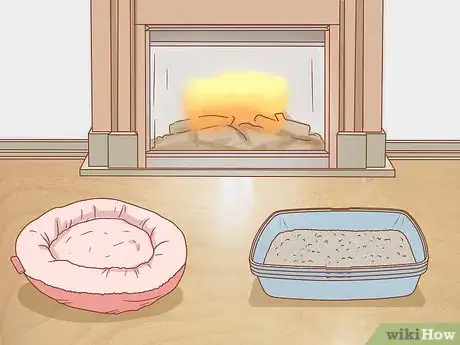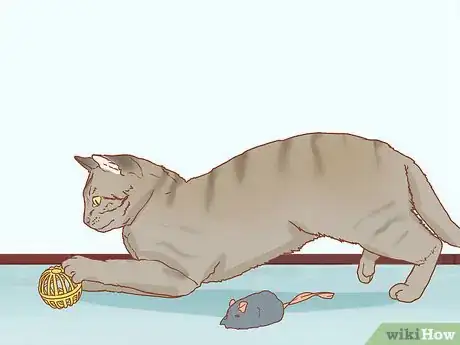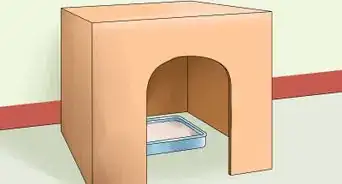This article was co-authored by Deanne Pawlisch, CVT, MA. Deanne Pawlisch is a Certified Veterinary Technician, who does corporate training for veterinary practices and has taught at the NAVTA-approved Veterinary Assistant Program at the Harper College in Illinois and in 2011 was elected to the board of the Veterinary Emergency and Critical Care Foundation. Deanne has been a Board Member of the Veterinary Emergency and Critical Care Foundation in San Antonio, Texas since 2011. She holds a BS in Anthropology from Loyola University and an MA in Anthropology from Northern Illinois University.
There are 10 references cited in this article, which can be found at the bottom of the page.
This article has been viewed 9,722 times.
When winter begins, it's important to make sure that your cat is protected from the cold. Whether it spends all day inside, spends a little time outside, or lives outside full-time, there are things you can do to help it through the cold winter months. Even if you don't have cats of your own, but you care for feral cats, winter care is very important. Above all, you need to make sure that any cats you care for have access to shelter, food, and water. With a little planning, care, and effort, both indoor and outdoor cats can thrive throughout the winter.[1]
Steps
Providing Winter Shelter
-
1Provide shelter outside. Outdoor cats will need shelter to protect them during the winter months. Providing shelter for your cat, or feral cats, can mean the difference between surviving and not surviving. Even if you only let your cat outside once in a while during the cold winter months, you should still give it somewhere outside where it can take refuge from the cold. This can be an area attached to your house or a stand-alone structure that gives the cat a break from cold temperatures and precipitation.[2]
- Possible shelters that you already have that can keep an outdoor cat safe and warm include a garage, a barn, or a porch or carport that blocks out the elements.
- Make sure that rain or snow cannot get inside the shelter. Any moisture inside the shelter can be transferred to your cat's coat, which in turn will make it colder when it leaves the shelter.
- Make sure that the entrance to whatever shelter you provide is small, so that warm air is trapped inside, and out of the path of wind and precipitation.
-
2Add insulation to your cat's shelter. Keeping a cat warm while it is outside may require that you add insulation to the shelter you provide. Add straw, foam insulation, or Mylar blankets, all of which will keep the cat warm but will not absorb and transfer moisture onto the cat.[3]
- Consider transforming a foam cooler into a cat shelter. Simply cut a small circular hole on the side of it that your cat can fit through. Place the cooler in a location that your cat frequents. This will create an insulated cat shelter that instantly gives your cat some protection from the cold.
Advertisement -
3Raise the shelter off the ground. If you have a stand-alone shelter for your cat and you live in an area that freezes, consider lifting it up off the ground. Place it at least a few inches off the ground and then insulate below it. This will stop the frozen ground from sucking the heat out of your cat's shelter. It will also make the shelter accessible even if a bit of snow piles up on the ground.[4]
- Once you raise your cat's shelter off the ground, you need to be sure to insulate the bottom of it. Cold winds blowing beneath it can really make the shelter cold.
Caring for Cats Outdoors
-
1Check local laws regarding outdoor cats. Outdoor cats are at high risk of being hit by cars, attacked by predators, or harmed by the elements. They also create environmental and public health hazards by hunting wildlife (such as songbirds) and pooping in public areas. For these reasons, many municipalities have laws regulating the care of outdoor cats. For example, if you keep or care for a cat that spends time outdoors, you may be required by law to:[5]
- Have your cat registered and microchipped.
- Have your cat spayed or neutered, and vaccinated regularly.
- Provide a particular type of outdoor shelter or housing.
- Feral or “community” cats need to be ear-tipped to signal that they have been trapped, neutered, and released. Ear-tipping involves the surgical removal of a small portion of one of the cat's ears.[6]
-
2Control when your cat goes outdoors. During winter, it may be a good idea to make sure your cat doesn't spend all of its time outside. At minimum, make sure that it isn't outside at the coldest times of day and night. Be aware of the weather forecast and bring your cat inside if a storm is expected or the weather is going to get especially cold.
- If temperatures are below freezing (32° F or 0° C), consider letting an outdoor cat spend time indoors, even if it's only inside your garage. Domestic cats' coats are not made to withstand really cold temperatures, and cats are highly susceptible to frostbite and hypothermia.[7] They will need your help to stay safe and warm.[8]
-
3Place food and water near the cat's shelter. If your cats are spending a lot of time outside, or you are caring for feral cats, you may need to feed them outside. If you do this, place the food and water close to a shelter area. This will make it so they don't need to go far to get access to it if weather conditions are very bad.[9]
- If you have already made a small shelter for your cat, for instance out of a foam cooler, consider making a second one to house your cat's food. Placing it next to the cat's shelter will allow the cat to have easy access.
-
4Make sure food and water don't freeze. If you are feeding cats outside during the winter, you need to keep the food and water temperature above freezing. One way to do this is to warm the food or water before putting it out. Warm up each of these things just slightly, so that your cat will have a warm dinner and the food and water won't freeze before the cat can enjoy them.[10]
- You may also want to consider buying a heated water or food bowl for an outside cat. These products plug into regular outlets and are typically available for purchase online.
- It is really important that you don't let your cat's water freeze. A cat can become dehydrated very quickly without access to water. This is particularly important for cats that live outside full-time in climates that freeze in the winter. They may have no other access to unfrozen water.
-
5Provide a heated sleeping area. If your cat stays outdoors during the winter, a heated cat bed can be a life-saver. Purchase a covered outdoor cat bed or shelter with electric heating to provide your cat with a warm, comfortable place to sleep.
Keeping Your Cat Comfortable Indoors
-
1Keep cat beds and litter boxes away from drafts. Many cats love to have their litter boxes and their beds in out of the way places where they can get a little privacy. However, during the winter you should make sure that the cat's bed and litter box are not so out of the way that they are in cold, drafty locations. Move these items closer to the warm areas of your home, so that your cat doesn't need to get cold to take a nap or go to the bathroom.[11]
- Also, if you place your cat's litter box in an area that is cold and drafty, the cat is more likely to avoid using it and it might begin going to the bathroom in other places in your home.
-
2Buy an indoor heated cat bed. If you want to keep your cat really cozy during the winter, get it a heated cat bed. These beds are available at most pet stores. They plug into regular wall outlets and provide gentle heating for your cat.[12]
- Heated cat beds are particularly good for cats that spend time in cool homes during the day. They can provide your cat a safe place to curl up if it gets chilled.
-
3Keep your cat active. If you keep your cat inside during the winter, or limit its time outdoors, you should make sure that it still gets regular and plentiful exercise. Make the time to play with it every day. Provide toys that it enjoys chasing after or batting at even when you are not around.[13]
- Some simple toys that cats tend to enjoy include toy mice, feathers on sticks, and balls with bells in the middle.
-
4Give access to sunshine. Even if it's cold outside, your cat can benefit from the warmth of the sun. If it is a sunny day outside, make sure that your cat can get to a spot where it can take a nap in the sunshine.[14]
- If your cat is particularly fond of napping in the sunshine, consider making it a special shelf in your windows for it to soak in the rays.
References
- ↑ http://www.humanesociety.org/issues/feral_cats/tips/caring_feral_cats_winter.html
- ↑ http://www.humanesociety.org/issues/feral_cats/tips/caring_feral_cats_winter.html
- ↑ http://www.vetstreet.com/dr-marty-becker/how-to-help-outdoor-cats-stay-warm-and-safe-in-winter-weather
- ↑ http://aspcapro.org/blog/2012/10/19/winter-cat-care-baby-its-cold-outside
- ↑ http://www.humanesociety.org/assets/pdfs/pets/feral-cats/nirenburg_hsus_cat_outdoors.pdf
- ↑ https://bestfriends.org/resources/ear-tipping-cats-what-it-why-it-done-it-humane
- ↑ https://www.playfulkitty.net/2016/01/08/5-myths-about-cats-in-cold-weather/
- ↑ https://www.vetmed.wsu.edu/outreach/Pet-Health-Topics/categories/miscellaneous-health-care-topics/cold-weather-pet-tips
- ↑ http://www.humanesociety.org/issues/feral_cats/tips/caring_feral_cats_winter.html
- ↑ http://www.humanesociety.org/issues/feral_cats/tips/caring_feral_cats_winter.html
- ↑ http://www.hillspet.com/en/us/cat-care/routine-care/keeping-your-cat-safe-during-winter
- ↑ http://cattime.com/cat-facts/lifestyle/12631-8-things-every-cat-owner-needs-to-get-through-the-winter
- ↑ http://www.catbehaviorassociates.com/keeping-your-indoor-cat-warm-in-winter/
- ↑ http://www.catbehaviorassociates.com/keeping-your-indoor-cat-warm-in-winter/
About This Article
To protect your cat during winter, provide outdoor shelter like your garage or porch so it has somewhere to go when it’s outside. Ideally, you should add straw, foam insulation, or Mylar blankets to the shelter to keep your cat warm inside. Additionally, if you’re feeding your cat outside, warm its food and water slightly and place them next to the shelter for easy access. If the temperature gets below freezing, bring your cat indoors since it may develop frostbite or hypothermia if left outside. For more advice from our Veterinary co-author, including how to keep your cat active in the winter, keep reading!
































































